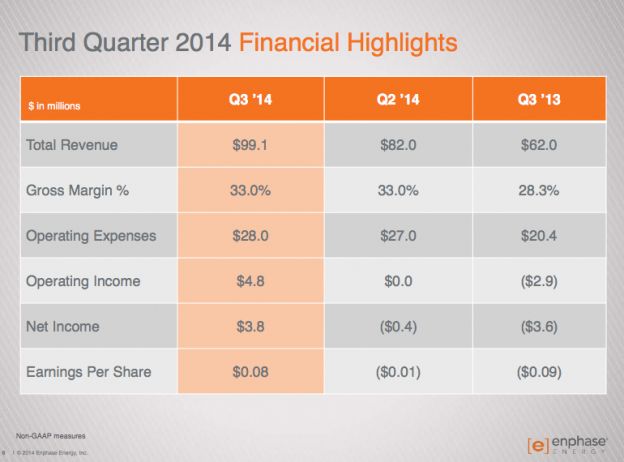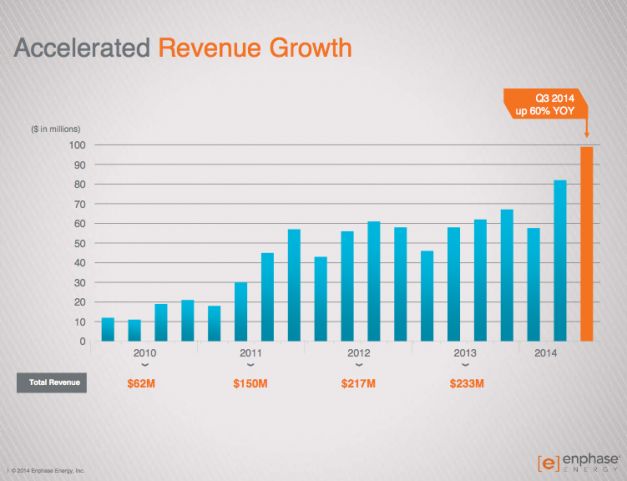Enphase announced its third-quarter results yesterday and showed a profit on record shipments of microinverters, as well as a move into new markets such as home energy management and energy storage. The company has strong margins (for a solar company) and a commanding lead in market share.
All of this seemed like relatively good news.
I guess this is why I'm not a solar sector stock market analyst.
Enphase stock price dropped 22.76 percent to $12.05 today after a strong gradual climb over the last few weeks and months.
Tim Radcliff at Morgan Stanley writes, "Management guided to revenues of $98 million to $103 million for 4Q14 -- higher than the conservative estimate of $94 million," but added,"However, gross margin of 31 percent to 33 percent was weak relative to the current conservative estimate of 33 percent."
Radcliff continues, "We believe that the new business could generate in excess of $100 million in annual revenues by the end of the decade. Perhaps more importantly, we believe that customer and market concentration represent overhangs for the stock, and new markets could mitigate these concerns." He alluded to "robust near-term earnings momentum, which offsets the specter of decreasing margins as key subsidies expire and competition intensifies in the coming years. We believe management has done a good job of demonstrating early growth beyond its initial California residential focus, but we believe much of this growth is already priced into the stock at current levels."
It's the company's margin guidance and pricing pressure that helped deflate the stock. A Q4 gross margin guidance of 31 percent to 33 percent is disappointing compared to Q3's 33 percent. CFO Kris Sennesael said Enphase is seeing "some increased pricing pressure." Margin concerns were one reason for BofA/Merrill's downgrade of Enphase last month.
Very few companies in solar, whether the players are downstream or upstream, are matching the gross margins that Enphase is reaching.
But Enphase wants to be treated more like a company with a Silicon Valley tech business model.
During last month's analyst day, CEO Paul Nahi said, "We're really the only company in the solar industry that has a tech business model. It's very standard for all of us, very prosaic in Silicon Valley, but wildly unique in solar. By that I mean, we focus our opex on the development of intellectual property -- semiconductor design, software, services so that we can provide more features, functions and products to our customers -- to help elevate our ASP while working with a Flextronics (a contract manufacturer) to continuously reduce our price and build products at the highest possible quality."
He continued, "That combination is where you see the gross margin expansion. That combination is the definition of a Silicon Valley hardware company -- that's what Enphase is."
If Nahi wants a stock valuation reflecting the "tech business model," then Enphase will have to keep growing its tech-business-model margins.
***
Here is our previous (and apparently optimistic) coverage of the Q3 earnings call.
Solar microinverter builder Enphase beat its revenue guidance and notched a profitable quarter with record revenue and unit shipments. The milestone marks Enphase's execution of late, as well as the solid growth of U.S. residential solar in 2014.
Enphase Q3 2014 highlights
-
The company reported revenue of $99.1 million, an increase of 60 percent year-over-year and up 21 percent versus Q2 2014. Revenue was above guidance and consensus
-
Enphase shipped 760,000 microinverters for a total of 170 megawatts (AC) of microinverter systems, an 81 percent increase in megawatts versus Q3 2013
-
Gross margin for Q3 was 32.8 percent, compared to 28.1 percent in Q3 last year and in line with guidance
-
Enphase hit GAAP net income for the first time bringing in net income of $800,000, compared to a net loss of $6.3 million in Q3 last year
-
The firm exited Q3 with a cash balance of $44.5 million
Earlier this month, Enphase introduced a fifth-generation microinverter system and a storage product as part of a home energy management system.
GTM Research weighs in
GTM Research's MJ Shiao notes that revenue per watt is down, but cost per watt is also down. He comments, "Enphase has a lot of momentum as module-level power electronics technology becomes more accepted in the market (thanks in large part to the efforts of Enphase) and the U.S. residential market continues to plug away at a blistering pace. Furthermore, National Electric Code requirements like rapid shutdown are temporarily helping boost demand as installers and string inverter suppliers are trying to find ways to deal with the new requirements without requiring product redesign or incurring significant additional installation costs."
Shiao continued, "Enphase's fifth-generation microinverter comes ahead of anticipated regulations for reactive voltage and other grid integration requirements in California and globally, and it should allow Enphase to continue shipping inverters into those markets without a hiccup. Partnerships with mounting manufacturers like Unirac and SunLink are also a smart play in terms of trying to squeeze out system costs without necessarily reducing component costs."
"This doesn't mean that Enphase is not facing challenges," Shiao said. "I think we're just starting to see the more serious module-level power electronics (MLPE) competition that's facing Enphase. SolarEdge has made an aggressive push into the U.S., and despite one analyst's crazy musings, a 2015 IPO seems to be on its way. KACO and Fronius now both have MLPE offerings (through licensed products), and LG is looking to enter with the first truly integrated AC module in a long time."
"Furthermore," Shiao continued, "with commercial string pricing continuing to fall, Enphase really has its work cut out for it in terms of expanding into the commercial market. Yes, some of the operational efficiency and redundancy arguments carry over to commercial, but smaller soft costs and raw pricing differences between three-phase string and microinverters will be incredibly difficult to overcome."
Q4 outlook
-
Revenue: $98 million to $103 million
-
Gross margin: 31 percent to 33 percent
-
Operating expenses: Up 8 percent to 10 percent sequentially as the firm invests in R&D



Enphase's Q2 highlights:
- Record revenue of $82.0 million, up 41 percent year-over-year
- Shipped 132 megawatts (or 598,000 microinverters), up 54 percent year-over-year
- GAAP gross margin for the second quarter of 2014 was 32.7 percent
- GAAP net loss for the second quarter of 2014 was $3.0 million



